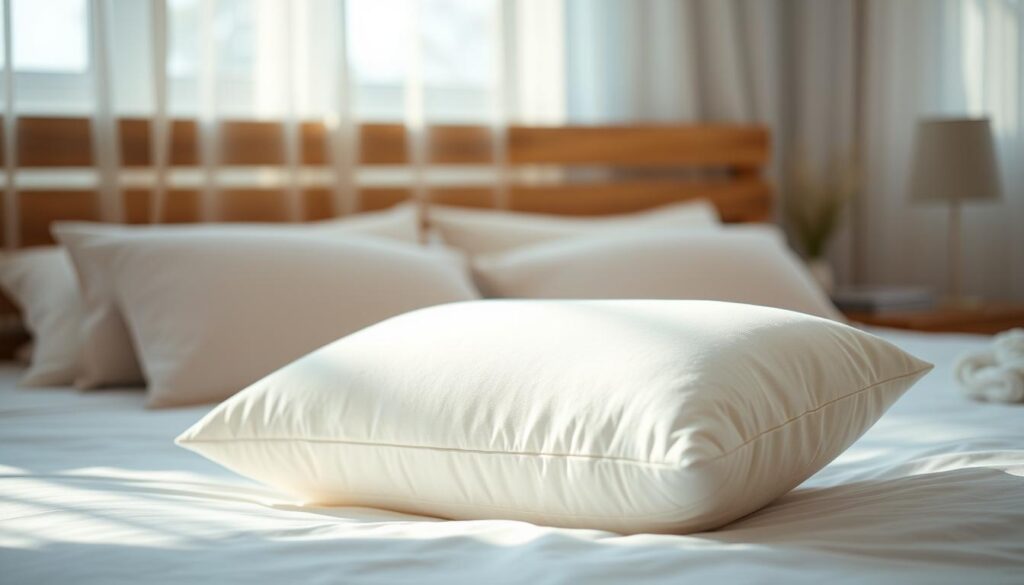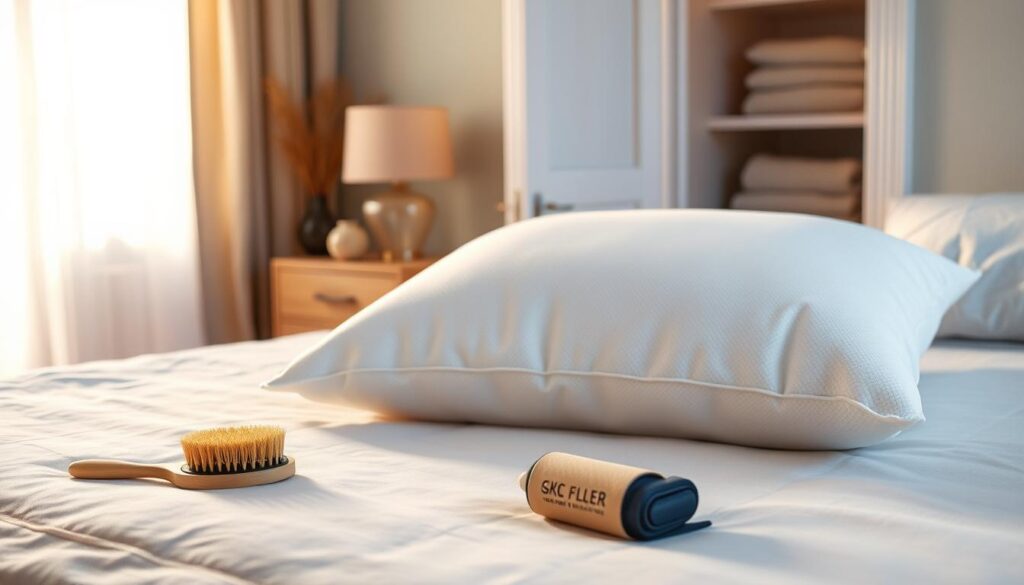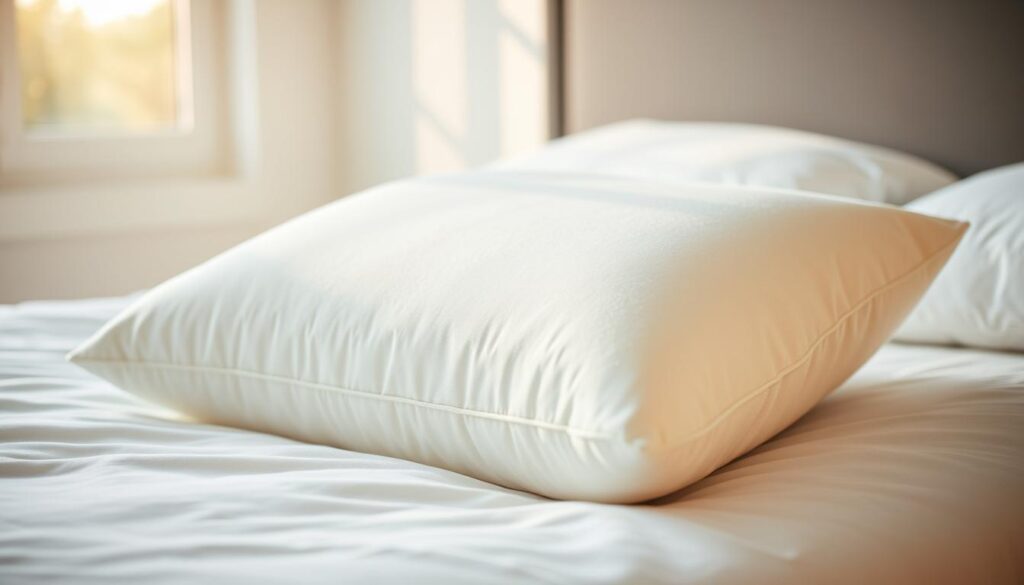Choosing the right pillow is essential for a good night’s sleep. Among the many options available, memory foam stands out for its comfort and support. But how long can you expect it to last? Understanding the lifespan of your foam pillow helps ensure you maintain optimal sleep quality over time.
A soft, inviting memory foam pillow rests on a clean, white bedsheet. The pillow’s surface is smooth and gently contoured, with a subtle sheen that catches the warm, natural light streaming in through a nearby window. The pillow’s slightly elevated shape suggests its ability to provide excellent neck and head support, while its plush, conforming texture evokes a sense of comfort and relaxation. The overall scene exudes a serene, soothing atmosphere, perfectly capturing the essence of a high-quality memory foam pillow that can provide long-lasting comfort and support.
Several factors influence how long a pillow remains effective. The material quality, usage frequency, and care routines all play a role. On average, a well-maintained foam pillow can last between two to three years. However, this varies depending on the type and brand.
This guide will explore the key aspects of memory foam durability, offering tips to extend its lifespan. By the end, you’ll have a clear understanding of when it’s time to replace your pillow and how to choose the best one for your needs.
Key Takeaways
- Memory foam pillows typically last two to three years with proper care.
- Material quality significantly impacts a pillow’s lifespan.
- Regular cleaning and maintenance can extend durability.
- Usage frequency and sleeping habits affect longevity.
- Replacing your pillow on time enhances sleep comfort and support.
Understanding Memory Foam Pillow Lifespan
Memory foam’s ability to contour to your body sets it apart from traditional pillows. This unique feature makes it a favorite for those seeking both comfort and support. But what exactly makes it so special, and how does its material composition contribute to its durability?
What Makes Memory Foam Unique
Memory foam is designed to respond to heat and pressure, molding to the shape of your head and neck. This contouring effect ensures proper alignment, reducing strain and discomfort during sleep. Unlike traditional pillows, which often flatten over time, memory foam retains its shape, providing consistent support night after night.
Experts highlight that this adaptability not only enhances sleep quality but also minimizes night-time discomfort. “Memory foam’s ability to distribute weight evenly helps alleviate pressure points,” says a sleep specialist. This makes it an excellent choice for those with neck pain or other sleep-related issues.
The Role of Material Composition
The durability of a foam pillow largely depends on its material composition. High-density memory foam is more resilient and long-lasting compared to low-density alternatives. This density ensures the pillow maintains its shape and support over time, reducing the need to replace it frequently.
Additionally, memory foam’s hypoallergenic properties make it a healthier option for sleepers. It resists dust mites and allergens, promoting a cleaner sleep environment. When compared to traditional pillows, memory foam stands out for its performance and longevity, making it a worthwhile investment for better sleep.
“A good quality memory foam pillow can provide years of comfort and support, making it a smart choice for anyone prioritizing sleep health.”
In summary, memory foam’s unique properties and superior material composition make it a standout option for those seeking lasting comfort and support. By understanding these factors, you can make an informed decision and enjoy better sleep for years to come.
Factors Influencing Pillow Longevity
Daily habits and material quality play a significant role in pillow longevity. From how often you use it to the way you clean it, these factors determine how long your pillow remains supportive and comfortable.

A cozy bedroom scene with a plush, memory foam pillow taking center stage. The pillow is positioned on a pristine white bedsheet, its soft, cloud-like texture inviting touch. Gentle morning light filters through sheer curtains, casting a warm, diffused glow on the scene. The pillow’s surface appears smooth and contoured, suggesting optimal neck and head support. In the background, a blurred wooden headboard and a few tasteful decorative accents create a soothing, minimalist ambiance. The overall mood is one of comfort, relaxation, and quality sleep.
Usage Patterns and Daily Wear
How you use your pillow impacts its lifespan. Frequent movement during sleep or improper positioning can lead to faster wear and tear. Over time, this can reduce its ability to provide proper support for your head and neck.
Body weight and sleeping habits also matter. Heavier individuals may compress the material more quickly, while restless sleepers can strain the pillow’s shape. These factors highlight why each person may experience different durability levels.
Quality, Density, and Construction
The materials used in your pillow are crucial. High-density foam resists deformation better, maintaining its shape and support for longer. Low-quality materials, on the other hand, may lose their structure quickly, leading to discomfort or even pain.
Regular care is essential to combat dust and bodily oils that accumulate over time. Washing your pillow cover and airing it out can prevent these elements from breaking down the material. Proper handling ensures your pillow stays fresh and functional for years.
By understanding these factors, you can take steps to extend your pillow’s life and enjoy better sleep quality. Small changes in usage and maintenance can make a big difference in durability.
Common Signs Your Pillow Needs Replacement
Over time, even the best pillows show signs of wear and tear. Recognizing these indicators ensures you maintain optimal sleep quality and avoid discomfort. Here’s how to tell when it’s time for a new one.
Visible Wear and Loss of Shape
One of the most obvious signs is visible wear. If your pillow has flattened or lost its original shape, it’s no longer providing proper support for your head and neck. This can lead to discomfort and even pain over time.
High-quality pillows may last up to three years, but daily use can accelerate wear. Regularly check for lumps, uneven surfaces, or a lack of resilience. These are clear signals that your pillow has exceeded its lifespan.
Discoloration and Odor Buildup
Discoloration and unpleasant odors are another red flag. Over time, natural oils from your skin and hair can seep into the pillow, causing stains and smells. This not only affects hygiene but also indicates material breakdown.
Using a pillow protector can help, but even with proper care, oils and sweat can degrade the material. If cleaning doesn’t restore freshness, it’s time to consider a replacement.
“A pillow that no longer supports your head and neck alignment can disrupt sleep and lead to long-term discomfort.”
Finally, consider how your pillow interacts with your mattress. Proper alignment between the two is essential for spinal health. If your pillow no longer complements your mattress, it’s a sign to upgrade. Paying attention to these signs ensures you enjoy consistent comfort and support every night.
Tips to Extend the Lifespan of Your Memory Foam Pillow
Simple habits can help your pillow stay fresh and supportive for years. Proper care is one of the most important factors in ensuring it lasts longer. By following a few easy steps, you can maintain its quality and avoid common signs of wear.

A cozy bedroom scene, soft afternoon light filtering through sheer curtains. In the foreground, a memory foam pillow sits atop a neatly made bed, its surface slightly textured, inviting touch. Nearby, a set of specialized pillow-fluffing tools – a gentle brush, a gentle lint roller – rests on a bedside table, hinting at the care and attention given to maintaining this cherished sleep essential. The background shows a tidy closet, shelves neatly stocked with fresh linens, suggesting a holistic approach to pillow upkeep. An aura of tranquility and mindfulness pervades the scene, capturing the essence of extending the lifespan of a memory foam pillow.
Proper Cleaning and Maintenance
Regular cleaning is a key factor in keeping your pillow in great shape. Follow the manufacturer’s instructions for washing. Some pillows can be spot-cleaned, while others may require gentle machine washing. Always ensure it’s completely dry before use to prevent mold or odors.
Another thing to consider is airing out your pillow. Let it breathe in a well-ventilated area to reduce moisture buildup. This simple step can help it last longer and stay fresh.
Utilizing Pillow Protectors Effectively
Using a pillow protector is one of the best ways to shield your pillow from stains, dust, and oils. These covers act as a barrier, preventing allergens from settling into the material. For those with allergies, this is a must-have accessory.
Pillow protectors also make cleaning easier. Simply remove and wash the cover regularly to maintain hygiene. This small effort is a strong reason why your pillow will stay in excellent condition for years.
“A clean and well-protected pillow not only lasts longer but also promotes better sleep hygiene.”
By addressing signs of wear early, such as stains or odors, you can extend the life of your pillow. These tips ensure it remains supportive and comfortable, reducing the need for frequent replacements. A little extra care now can make a big difference in the years to come.
how long do memory foam pillows last: A Detailed Comparison
Not all pillows are created equal, and material choice plays a significant role in their performance. Understanding the differences between memory foam and other materials can help you make an informed decision. This section will compare memory foam to alternatives like down, latex, and buckwheat, highlighting their durability, support, and impact on sleep health.
Comparing Memory Foam to Other Pillow Materials
Memory foam is known for its ability to contour to your back and neck, providing consistent support. Unlike down pillows, which flatten over time, memory foam retains its shape, making it a durable choice. Latex pillows are also resilient but may feel firmer, which isn’t ideal for everyone.
Buckwheat pillows, on the other hand, offer adjustable support but can be noisy and heavy. While they last a long time, they require frequent fill adjustments to maintain comfort. Memory foam strikes a balance between durability and comfort, making it a popular option for many sleepers.
Best Practices from Industry Experts
Experts recommend replacing your new pillow every two to three years, depending on usage. High-quality memory foam tends to last longer due to its dense material. Proper care, such as using a pillow protector and airing it out regularly, can extend its lifespan.
Manufacturers often suggest rotating your pillow every few months to ensure even wear. This simple step can help maintain its shape and support. Additionally, keeping your pillow clean and free from oils and sweat will protect it from premature breakdown.
“Choosing the right pillow material is essential for spinal health and overall sleep quality. Memory foam’s adaptability makes it a top choice for many.”
When it’s time replace your pillow, consider how different materials respond to wear. Memory foam’s resilience and hypoallergenic properties make it a smart investment for long-term comfort. By following expert advice, you can ensure your pillow stays in great shape for years to come.
Conclusion
Maintaining your pillow’s quality is essential for long-lasting comfort support. Over time, signs like stains, odors, or loss of shape indicate it’s time to replace it. Proper care, such as using a pillow case or protector, can prevent bacteria buildup and extend its lifespan.
Regular cleaning and airing out your pillow are simple yet effective ways to preserve its health and hygiene. Recognizing these signs early ensures you enjoy uninterrupted sleep quality. Integrating these best practices into your routine keeps your pillow fresh and supportive.
Informed maintenance and timely upgrades are key to lasting comfort support. Monitor your pillow’s condition regularly to ensure it continues to meet your needs. A well-cared-for pillow not only enhances sleep but also promotes overall health.
FAQ
What makes memory foam pillows unique compared to other types?
Memory foam pillows are designed to contour to your head and neck, providing customized support. This material adapts to your body’s shape, reducing pressure points and improving comfort during sleep.
How does the material composition affect the lifespan of a memory foam pillow?
The density and quality of the foam play a significant role. High-density foam tends to last longer, while lower-quality materials may lose shape and support more quickly.
What factors influence how long a memory foam pillow lasts?
Usage patterns, body oils, sweat, and proper care all impact longevity. Frequent use without maintenance can shorten its lifespan, while regular cleaning and protection can extend it.
What are the signs that it’s time to replace a memory foam pillow?
Look for visible wear, loss of shape, discoloration, or persistent odors. These are clear indicators that your pillow is no longer providing the comfort and support you need.
How can I extend the life of my memory foam pillow?
Use a pillow protector to guard against stains and dust mites. Regularly air it out and follow the manufacturer’s cleaning instructions to maintain its quality and hygiene.
How does memory foam compare to other pillow materials in terms of durability?
Memory foam generally lasts longer than traditional pillows due to its resilient structure. However, proper care is essential to maximize its lifespan compared to materials like down or polyester.
What are the best practices for maintaining a memory foam pillow?
Avoid exposing it to direct sunlight for extended periods, spot clean stains promptly, and use a breathable pillowcase. These steps help preserve its shape and prevent bacteria buildup.

